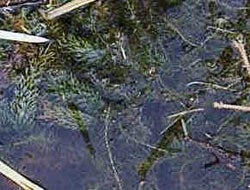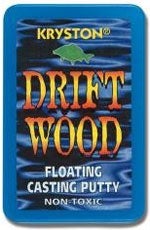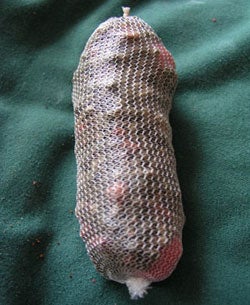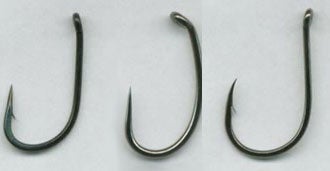| The following article is all about fishing in a weedy environment – specifically carp fishing in weed. I’ll put forward my thoughts on the various problems the presence of weed can bring about and offer suggestions that have worked for me in coping with these conditions. Weed can be a nightmare, but it can also be the carper’s friend! Weed doesn’t worry me that much, and by applying a bit of common sense, any potential problem can be overcome. In September last year I encountered a lake in France that was so weedy it was difficult to find a clear spot at all! So, for anyone faced with this situation for the first time, I empathise with you totally. However, before we get down to the nitty-gritty, let us look initially at the various types of weed present in this country to gain a little understanding of what we are dealing with.
Blanketweed (Cladophora glomerata) also known as Filamentous Algae Silkweed (Asclepias syriaca) Duckweed (Lemna spp)
Rigid Hornwort (Ceratophyllum demersum) and Frogbit (Hydrocharis morsus-ranae) Canadian Pondweed (Elodea canadensis) Mare’s Tail (Hippurus vulgaris) Australian Stonecrop (Crassula helmsii)
The Yellow Water Lily (Nuphar lutea) Out of the above, I’d say the most common that can potentially cause problems for the angler are Blanketweed, Silkweed, Canadian Pondweed, and the Water Lily. Whilst the latter is an undoubtedly beautiful aquatic plant, if unchecked it can completely cover a lake. Let’s get down to the crux of the matter Over several years, I’ve read and listened to a lot of advice regarding fishing in weed and, generally speaking, it has been relevant and has served me well. We can’t get it right all the time of course, but there are certain helpful hints that can aid us in achieving our objectives – to catch those elusive big carp. When fishing weedy waters we need to look at certain aspects that will play their part, and which can make a difference as to whether we are successful or otherwise. By keeping the basic principles in mind we can succeed; baits, rigs, tactics and their application, they all matter and its all about getting it right on the day. I have found that some carp anglers seem a little scared of fishing in weed, but over time one learns certain techniques for coping with weed. For instance, in September last year (2004) I fished a venue in the Champagne region of France where there was no open water to speak of (see picture).
therefore the carp had to find their food, and hopefully with it my bait, in the very thick weed that was present, which actually grew all over the lake and from top to the bottom. This really was the worst I’d ever seen! It was impossible to use a marker set up with any degree of success. However, it offered a challenge, and that’s what it’s all about. Wherever we are fishing, location is of primary importance, never more so than when fishing in weed. To catch them we have to find them, right? To simply drop a bait in a gap in the weed is, to be honest, as pointless as launching a bait to the horizon for no reason. So, it’s even more important that we find them first; using my trip last September as an example, I had to try to work out where the carp were, and why they were there. Whilst walking round the lake I made my choices as to where my preferred swims were and so when it came to the draw and thus decision time, I ended up having my second choice, which I was happy with. However this presented me with extra problems: I found out the weather was going to be extremely hot – pushing 90 deg F all week. This meant that any feeding by the carp was probably going to be sporadic! This turned out to be exactly the case, so I had to get my thinking cap on! Moving wasn’t much of an option as it was also a holiday for my wife, and swims were limited, I therefore had to make the best of what I had! I opted initially for surface fishing methods, using dog biscuits and floating pellets, and as we know these can be devastatingly effective – if only I could get them feeding on the surface. I tried but with no success! Whilst walking round I had seen some activity in my chosen swim, which included seeing one reasonably-sized carp break the surface, and a small coypu being spooked off immediately after diving in a nearby spot, I took this to possibly be a big carp in the vicinity. Things looked promising! That first evening, after having no luck with the floaters, I took a look around my swim with the row-boat only to see that where I thought there were gaps in the weed – there weren’t! There was just less weed in places! Having been told by the lake owner that big beds of bait hadn’t worked there for weeks, I heeded this advice, and opted to have a play with the marker rod – only minus the float for obvious reasons! What this showed me was the weed, upon closer inspection, was full of aquatic life. This accounted for why the carp were in amongst it rather than avoiding it. Anyway, to cut this story short and to get on with the crux of the article, suffice it to say that I landed just two fish all week from three runs. I had to work hard, and these were caught by applying some of the principles laid out below.
Bear in mind the simple assumption that in weed the further out one is fishing the more weed one has to negotiate when bringing the carp to the net. Therefore, if carp can be located around 10 yards out and say 50 yards out, and each appears to be similarly fishable, then we should not be making it any harder for ourselves by opting to fish at 50yards! Every yard in a weedy water can make all the difference; unlike in open water where the carp can be allowed to run. I will often use popped-up baits straight off the lead so that it remains visible, and this is okay in the spring when weed growth is limited, but not later on in the summer months. Canadian Pondweed grows in long strands, many of which can be several feet in length; couple this with the fact that both Blanket Weed and Silk Weed tangles itself around other plant-life, a bait presented in this way will often be completely invisible. Therefore fishing a pop-up with a shortish hooklength is a completely pointless act. A way round this is use a hooklength slightly longer than the depth of the weed, having first ascertained the depth with a marker. You will also need to establish the density of the weed. It is no good adopting this method if it is dense. If it is dense, ie, there is a great deal of filamentous algae or blanket weed present, especially along with Canadian Pondweed or anything else for that matter, then a different approach can be adopted, and this is the method I chose to adopt which helped me catch the two carp as mentioned above, and this is basically fishing on top of the weed. But this method can only be embraced if fishing quite close in, which will be explained: It must be ensured that this rig sinks slowly, and for this reason I use a critically balanced hookbait on a quite thin braid hooklength. As for the rest of the set-up, I will not use a lead but to achieve any sort of distance, ie, other than freelining, I squeeze a mixture of normal tungsten putty and some of the floating variety (Kryston Driftwood for instance) but only just enough to get it to the spot you want to present the bait. It is a case of experimenting until you get the balance right.
But one thing that has to be remembered with this set up is that it is not a self-hooking arrangement, therefore it needs to be fished with a typical, sensitive indication, and you’ll need to be on your rods. One hears anglers complaining all the time that a decent sized carp has weeded them up, and yet they will still wander off? Get as close and stay as close as is practical. Again, a balance needs to be struck as you don’t want to be spooking any carp that are nearby. In this connection, if practicable, I will have my rods back from the water’s edge. A state of equilibrium needs to be maintained when setting up too; you want everything to hand, but you also don’t fall to be falling over rods or whatever when you get a run in the middle of the night. If Water Lilies are present, don’t be afraid to ‘get amongst’ them, especially if little else in the way of aquatic plants is present! Carp are often found among lilies, and at different depths according to whatever aquatic life is present. You will need strong tackle, from rod to hook and you will usually have to fish ‘locked-up’ and be right on your rods! So it is wise to bear this in mind. Although you know the carp are there, you need to ensure they are feeding where you want them to feed, ie, where your hookbait is, and in this situation I would fish a bottom bait or a bait popped-up at the most off the eye of the hook – any more and in my opinion you run the risk of getting caught in amongst the stems of the Lilies. You also want freebies around your hookbait. This where PVA bags and Sticks come into their own. It used to be that people wouldn’t use PVA as some considered it too costly and too fiddly; but this is not the case and well worth the effort of using. Except for when I am fishing a single hookbait on its own, I will normally utilize a PVA bag to some degree or other. Filled with boilie crumb, pellets etc, one is guaranteed that the hookbait has a nicely presented quantity of freebies and feed around it.
But another great advantage of using PVA bags in this situation is that you know your hookbait is protected on the cast, and not in weed or snagged up. You will need a decent sized lead to ensure the bag is on the bottom where you want it. Some anglers will place the lead in the bag to ensure this is the case, however an alternative is to place a stone in the bag and the end result is the same. No matter what type of weed one is fishing in, it is always advisable to utilize a PVA Nugget pinched on to the hook-point, as this will protect it on the cast and for at least a few seconds as your hookbait settles on the lake bottom. Now for a look at tackle Both line and hook choice have been many people’s failing when fishing in and around weed. But we are actually spoilt for choice with regards to mono these days with improvements being made all the time; and good old cheap and cheerful Daiwa Sensor being one of my favourite main-lines. But with the likes of Fox Soft Steel, Krystonite, Technium, GR60 – the list is almost endless, and providing one’s knots are up to standard then all should be okay. Go for a sufficiently strong Breaking Strain, or if you prefer, like me, use a strong Braid such as Power Pro. Mono is of course more forgiving, but for fishing locked up in weed, you need to be able to be ‘in control’ as soon as possible, and for me braid offers a distinct advantage. As with line, there are some excellent hooks for fishing in weed, and again, we are almost spoiled for choice, We all have our personal preferences, but a little research will tell you that most hooks are made in Japan or China, there are exceptions, but the chances are that your hook could be made at the same factory, in fact could be the same hook as someone else’s preferred choice, just sold with a different label on it! The most important thing is to ensure it is up to the job! Gardner Mugga’s, Drennen boilies hooks, Kamasan B175, Big T’s, Ashima, etc, etc, all are good in their own way, but often we hear of anglers experiencing problems with hooks opening up or straightening, etc, and I believe this is more down to hook-choice rather than a hook actually being bad! In my own experience, though many people have confidence in the Kamasan B175 for example, and I agree it’s a good hook for most situations, but I would not recommend it for use in weed, I’d advise something like a Nash Fang or a Nailer, or better still an Ashima Super Heavy.
If you do decide to use leads in the weed, then it is doubly important to ensure the lead can discharge very easily! Obviously leads are vital in the cast unless you are fishing close in, and to hook the carp, so they cannot be taken out of the reckoning! So, to emphasise, use a lead system which easily releases the lead if a carp runs into the weed; as explained previously, if the set-up is minus a lead, the chances of landing the carp are increased tenfold. I have already stressed the importance of being on your rods the instant you get a take; logically therefore, the more rapidly you receive notification of a take the sooner you can be in a position of control. Consequently, if you are using bite alarms, and in practically all situations we would be, ensure the sensitivity is set at its highest. In this situation I prefer light hangers to swingers because of the greater sensitivity they offer. Ultimately, when playing a carp in and/or around weed it is sometimes difficult to decide whether to play it hard or to ease off. You don’t want to be tearing its head off, but by the same token, determination needs to be shown to dictate the situation. YOU NEED TO BE IN CONTROL! Again, it’s all about balance. If the carp is taking line and you feel you can allow it to do so, then fine; if you can’t, then use the rod to cushion the carp’s lunges, or if you are using mono, the stretch of the line will do the same. If you do get ‘weeded up’ and you really can’t budge it in any way, leave the rod on the bite alarm for a while with your baitrunner set and allow it a chance to free itself – your patience can sometimes be rewarded. Otherwise, if allowed, a boat can be used to free the carp. Having chosen your tackle wisely you should have the confidence required to bring the carp to the net – if you are still worried about your line breaking, your knot giving way, or your hook opening up after reading the above, then don’t attempt to fish in weed until you have more experience and therefore the confidence that comes with it. As a final point, in some waters carp will actually avoid the weedy areas; I’m sure there are many and varied reasons for this – some of which we can guess at, and sometimes in all honesty we just haven’t a clue. In these cases it is better to just find clearer areas that may contain carp. But if you are confident the carp are present in the weed and, equally important, that they are feeding there, then by adopting some of the methods above, I’m sure you’ll be successful.
|
Welcome!Log into your account



















